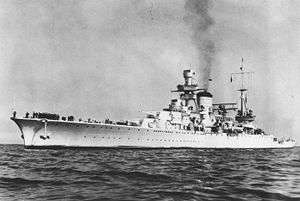Veinticinco de Mayo-class cruiser
 Argentinian Cruiser ARA 25 de Mayo | |
| Class overview | |
|---|---|
| Builders: | OTO, Livorno |
| Operators: |
|
| In commission: | 1931 - 1961 |
| Planned: | 3 |
| Cancelled: | 1 |
| Retired: | 2 |
| General characteristics ARA Veinticinco de Mayo | |
| Displacement: |
|
| Length: | 171 m (561 ft 0 in) |
| Beam: | 17.82 m (58 ft 6 in) |
| Draught: | 4.66 m (15 ft 3 in) |
| Propulsion: | 2 shaft Parsons turbines, 6 oil-fired boilers, 85,000 hp (63,000 kW) |
| Speed: | 32 knots (59 km/h) |
| Range: | 8,030 nautical miles (14,870 km) at 14 knots (26 km/h) |
| Complement: | 780 |
| Armament: |
|
| Armour: |
|
| Aircraft carried: | 2 × Grumman J2F Duck aircraft |
| Aviation facilities: | Catapult launcher |
The two Veinticinco de Mayo-class heavy cruisers served in the Argentine Navy through World War II. They were the only post-Washington Naval Treaty heavy cruisers built for a South American Navy. Both ships of the class were built in Italy by the OTO company, and commissioned into the Argentine Navy in 1931.
Design
The Veinticinco de Mayo design was derived from the Italian Trento class, identifiable by the closely paired main guns, similar to the last batches of the Condottieri-class cruisers. The ships were smaller than the original, and carried significantly less armour. They had a clean and simple design, with a length-width ratio of almost 10:1. Three twin turrets were mounted with an elevation of 46 degrees for firing.
They were not the first Argentinian cruiser class bought in Italy, as four Giuseppe Garibaldi-class armoured cruisers were brought into service 30 years before.
Armament
The main 190 mm (7.5 inch) guns were designed especially for this class for greater stability (the Trento class carried 203 mm (8 inch) guns). This could have been a quite powerful gun, but no documents about its characteristics are available in Italian or Argentinian archives. The guns had single mounts to simplify construction, and could fire a 90 kg (200 lb) shell up to 23 kilometres (25,000 yd). Despite this reduction in size and weight, they were still too heavy, so the number of turrets were reduced from four to three. In most respects the resulting vessel was similar in profile to the British York class.
The secondary armament was also a new design, similar to standard 100–102 mm guns of the time. It consisted of twelve 102 mm (4 inch)/45 DP guns, firing a 13.5 kg (30 lb) shell, all in twin mounts. This was an unusual arrangement for Italian heavy cruisers, which generally carried sixteen of these weapons. However to counter the additional weight, gun shields were removed, which adversely affected their operability in bad weather conditions.
Unusually, the torpedo tubes were in fixed mounts amidships firing abeam, which caused problems in aiming effectively.
Light anti-aircraft artillery consisted of six Vickers-Terni 40/39 mm guns, all in single mounts, on the aft part of the superstructure. These guns were among the first automatic heavy weapons, firing 100-130 rounds per minute, but were of poor reliability. Though single mounts were simpler and more reliable, they offered poorer fire concentration. The Royal Navy used similar weapons in quad or even octuple mounts. Finally, a catapult launcher for seaplanes was placed over the fore deck.
Armour was within the standard for light rather than heavy cruisers. A 70 mm (2.8 in) armoured belt was fitted from the first to the last main turret. 60 mm (2.4 in) was used for the command turret. 50 mm (2.0 in) was used for turrets and barbettes. Only 25 mm (0.98 in) was provided for the armoured deck and above aft machinery.
Post-war refit
After World War II the ships were modified to improve their stability by reducing weight. The powerful twin 102 mm gun batteries were replaced with six Bofors 40 mm guns, one for each twin mount, drastically reducing the secondary armament. Another four Bofors replaced the six Vickers AA guns. US Mk.53 radar directors were also installed to improve the effectiveness of anti-aircraft fire. The gain in stability, with several tons removed for each 102 mm gun, was somewhat offset by the addition of radar installations to the superstructure and masts. The aircraft catapult launcher was moved from the fore deck to mid-ships.
Units
Despite Argentina's declaration of war on 27 March 1945, neither vessel played a role in the conflict. The ships proved popular with the Argentine Navy, until they were superseded by two Brooklyn-class cruisers acquired in 1951.
Veinticinco de Mayo (C-2)
Named after the 25th of May, Argentina's National Day. Built by OTO La Foce, Italy, laid down 12 October 1927, launched 28 September 1929, completed 18 July 1931. Decommissioned 27 June 1961.
Almirante Brown (C-1)
Named after Admiral Guillermo Brown, father of the Argentine Navy. Built by OTO Livorno, laid down 27 November 1927, launched 11 August 1929, completed 11 July 1931. Decommissioned 27 June 1961.
Planned units
Argentina originally planned to acquire three of the class, but were limited to having only two built. They would turn to the United Kingdom for their next cruiser, acquiring La Argentina in 1938.
See also
References
- M.J Whitley, Cruisers of World War II, An International Encyclopedia (1995) Arms and Armour Press
- Article in "Storia Militare" magazine, October 2007. (in Italian)
Further reading
- Burzaco, Ricardo. Acorazados y Cruceros de la Armada Argentina. Eugenio B, Buenos Aires, 1997. ISBN 987-96764-0-8 (in spanish)
- Arguindeguy, Pablo. Apuntes sobre los buques de la Armada Argentina (1810-1970). Comando en Jefe de la Armada, Buenos aires, 1972. ISBN n/d (in spanish)
External links
- History of argentinian cruisers, at HISTARMAR (in spanish)